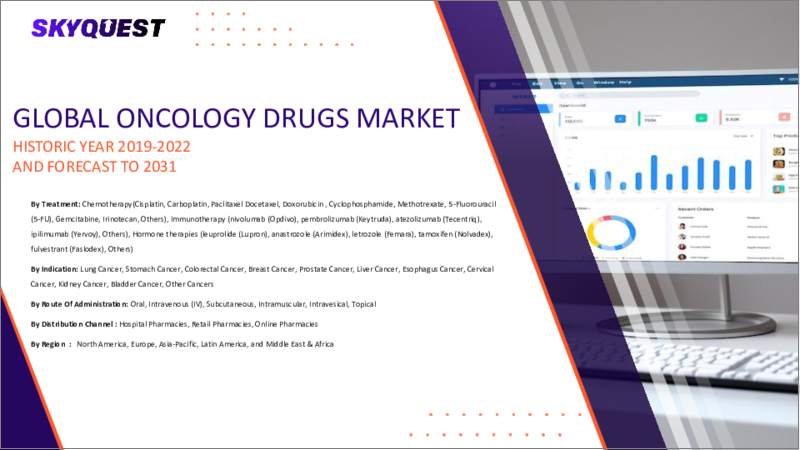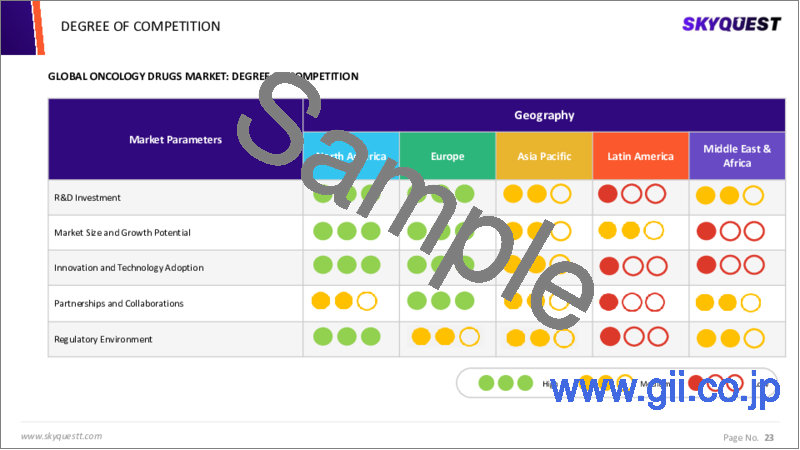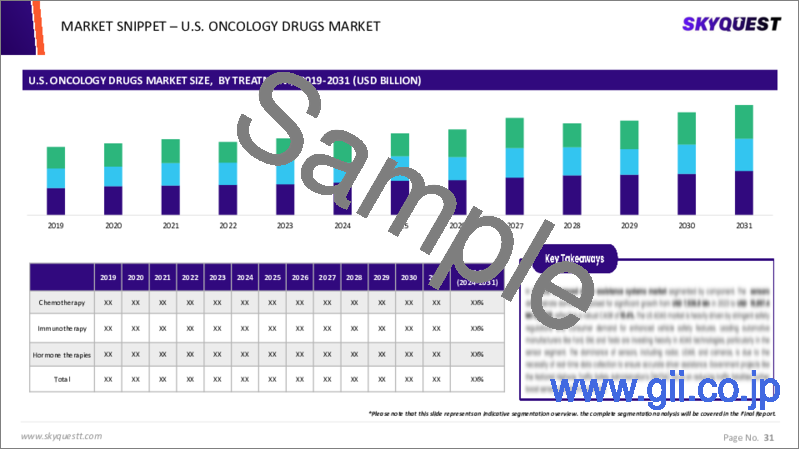|
|
市場調査レポート
商品コード
1566159
がん治療薬の市場規模、シェア、成長分析、薬剤クラス別、療法別、適応症別、剤形別、地域別 - 産業予測、2024年~2031年Oncology Drugs Market Size, Share, Growth Analysis, By Drug Class, By Therapy, By Indication, By Dosage Form, By Region - Industry Forecast 2024-2031 |
||||||
|
|||||||
| がん治療薬の市場規模、シェア、成長分析、薬剤クラス別、療法別、適応症別、剤形別、地域別 - 産業予測、2024年~2031年 |
|
出版日: 2024年10月05日
発行: SkyQuest
ページ情報: 英文 157 Pages
納期: 3~5営業日
|
全表示
- 概要
- 目次
がん治療薬の世界市場規模は、2022年に1,190億米ドルと評価され、2023年の1,336億4,000万米ドルから2031年には3,380億4,000万米ドルに成長し、予測期間中(2024年~2031年)のCAGRは12.3%で成長する見通しです。
世界のがん治療薬市場は、製薬業界において急速に発展している重要な分野です。がん治療薬は、一般に抗がん剤や化学療法薬と呼ばれ、様々な種類のがんの診断、治療、管理のために特別に開発されたものです。これらの医薬品は、がん細胞を標的として増殖を抑制したり、がん細胞を完全に除去したりするため、がんとの闘いに不可欠です。この市場は、いくつかの要因によって大きな成長を遂げています。世界のがん罹患率の上昇が、高齢化、不健康なライフスタイル、環境暴露、遺伝的素因などの要因に影響され、効果的な治療に対する需要を押し上げています。さらに、医学研究と技術の進歩は、革新的ながん治療法の開発につながった。研究者や製薬会社は、標的療法、免疫療法、個別化医療など、患者の転帰や生存率の改善が期待できる新しい治療法を継続的に模索しています。がん治療薬市場は多様性に富んでおり、肺がん、乳がん、大腸がん、前立腺がんなど、さまざまながん種を対象とした幅広い種類の薬剤が、経口剤、注射剤、点滴などの形態で販売されています。この分野は競争が激しく、大手製薬会社は新製品を市場に投入するため、研究、臨床試験、規制当局の承認、マーケティングに多額の投資を行っています。全体として、がん治療薬市場は、がんと闘い、患者の予後を向上させるという継続的なニーズが原動力となっている、製薬業界にとってダイナミックで不可欠な分野です。継続的な投資、調査、協力は、進化するがんの課題に対処し、効果的な治療法に対する世界の需要を満たすために不可欠です。
目次
イントロダクション
- 調査の目的
- 定義
- 市場範囲
調査手法
- 情報調達
- 二次データソースと一次データソース
- 市場規模予測
- 市場の想定と制限
エグゼクティブサマリー
- 市場概要見通し
- 供給需要動向分析
- セグメント別機会分析
市場力学と見通し
- 市場力学
- 促進要因
- 機会
- 抑制要因
- 課題
- ポーターの分析
主な市場の考察
- 技術分析
- 価格分析
- バリューチェーン分析
- 市場のエコシステム
- 貿易分析
- サプライチェーン分析
- ケーススタディ分析
- 特許分析
- 規制情勢
- イノベーションマトリクス
- 主な投資の分析
- 主な成功要因
- 競合の程度
がん治療薬市場:薬剤クラス別
- 市場概要
- 細胞毒性薬
- アルキル化剤
- 代謝拮抗物質
- その他
- 標的薬
- モノクローナル抗体
- その他
- ホルモン剤
- その他
がん治療薬市場:療法別
- 市場概要
- 化学療法
- 標的療法
- 免疫療法
がん治療薬市場:適応症別
- 市場概要
- 肺がん
- 胃がん
- 大腸がん
- 乳がん
- 前立腺がん
- その他
がん治療薬市場:剤形別
- 市場概要
- 固体
- 錠剤
- カプセル
- 液体
- 注射
- プレフィルドシリンジ
- その他
がん治療薬市場:流通チャネル別
- 市場概要
- 病院薬局
- 小売薬局
- オンライン薬局
がん治療薬市場規模:地域別
- 市場概要
- 北米
- 米国
- カナダ
- 欧州
- ドイツ
- スペイン
- フランス
- 英国
- イタリア
- その他欧州地域
- アジア太平洋地域
- 中国
- インド
- 日本
- 韓国
- その他アジア太平洋地域
- ラテンアメリカ
- ブラジル
- その他ラテンアメリカ地域
- 中東・アフリカ(MEA)
- GCC諸国
- 南アフリカ
- その他中東・アフリカ地域
競合情勢
- 上位5社の比較
- 主要企業の市場ポジショニング(2023年)
- 主な市場企業が採用した戦略
- 市場における最近の活動
- 主要企業の市場シェア(2023年)
主要企業プロファイル
- F. Hoffmann-La Roche Ltd.(Switzerland)
- Amgen(US)
- Novartis AG(Switzerland)
- Bristol-Myers Squibb Company(US)
- Pfizer Inc.(US)
- Astellas Pharma Inc.(Japan)
- Johnson & Johnson(US)
- AstraZeneca plc(UK)
- AbbVie Inc.(US)
- Merck & Co., Inc.(US)
- Eli Lilly and Company(US)
- Sanofi S.A.(France)
- Gilead Sciences, Inc.(US)
- Regeneron Pharmaceuticals, Inc.(US)
- Incyte Corporation(US)
- Vertex Pharmaceuticals Incorporated(US)
- Seagen Inc.(US)
- Blueprint Medicines Corporation(US)
- Mirati Therapeutics, Inc.(US)
- Xencor, Inc.(US)
- NantKwest, Inc.(US)
- Zymeworks Inc.(Canada)
- Karyopharm Therapeutics Inc.(US)
- Exelixis, Inc.(US)
Global Oncology Drugs Market size was valued at USD 119 billion in 2022 and is poised to grow from USD 133.64 billion in 2023 to USD 338.04 billion by 2031, growing at a CAGR of 12.3% during the forecast period (2024-2031).
The global oncology drug market is a rapidly advancing and crucial segment of the pharmaceutical industry. Oncology drugs, commonly referred to as anticancer or chemotherapy drugs, are specifically developed to diagnose, treat, and manage various types of cancer. These medications are essential in the fight against cancer, as they target and inhibit the growth of cancer cells or eliminate them entirely. The market has experienced significant growth due to several contributing factors. The rising incidence of cancer globally has driven up the demand for effective treatments, influenced by factors such as an aging population, unhealthy lifestyles, environmental exposures, and genetic predispositions. Additionally, advancements in medical research and technology have led to the development of innovative oncology therapies. Researchers and pharmaceutical companies are continuously exploring new treatment options, including targeted therapies, immunotherapies, and personalized medicine, which have demonstrated promising improvements in patient outcomes and survival rates. The oncology drug market is diverse, with a broad range of medications aimed at different cancer types, such as lung, breast, colorectal, and prostate cancers, available in forms like oral pills, injectables, and intravenous infusions. This sector is highly competitive, with major pharmaceutical companies investing heavily in research, clinical trials, regulatory approvals, and marketing to bring new products to market. Overall, the oncology drug market is a dynamic and essential area of the pharmaceutical industry, driven by the ongoing need to combat cancer and enhance patient outcomes. Continued investment, research, and collaboration are vital to addressing the evolving challenges of cancer and meeting the global demand for effective treatments.
Top-down and bottom-up approaches were used to estimate and validate the size of the Global Oncology Drugs market and to estimate the size of various other dependent submarkets. The research methodology used to estimate the market size includes the following details: The key players in the market were identified through secondary research, and their market shares in the respective regions were determined through primary and secondary research. This entire procedure includes the study of the annual and financial reports of the top market players and extensive interviews for key insights from industry leaders such as CEOs, VPs, directors, and marketing executives. All percentage shares split, and breakdowns were determined using secondary sources and verified through Primary sources. All possible parameters that affect the markets covered in this research study have been accounted for, viewed in extensive detail, verified through primary research, and analyzed to get the final quantitative and qualitative data.
Global Oncology Drugs Market Segmental Analysis
Global Oncology Drugs Market is segmented by Drug Class, Therapy, Indication, Dosage Form, Distribution Channel, and Region. Based on Drug Class, the market is segmented into Cytotoxic Drugs, Targeted Drugs, Hormonal Drugs, Others. Based on Therapy, the market is segmented into Chemotherapy, Targeted Therapy, and Immunotherapy. Based on Indication, the market is segmented into Lung Cancer, Stomach Cancer, Colorectal Cancer, Breast Cancer, Prostate Cancer, and Others. Based on Dosage Form, the market is segmented into Solid, Liquid, Injectable, and Other. Based on Distribution Channel, the market is segmented into Hospital Pharmacies, Retail Pharmacies, and Online Pharmacies. Based on region, the market is segmented into North America, Europe, Asia Pacific, Latin America and Middle East & and Africa.
Drivers of the Global Oncology Drugs Market
The rising global incidence of cancer is a major factor propelling the growth of the oncology drug market. Contributing factors include aging populations, changes in lifestyle, and environmental influences, all of which increase the overall burden of cancer. This heightened demand for effective treatments is consequently driving the need for oncology drugs. As the prevalence of cancer continues to rise, there is an urgent need for advanced and effective treatment options. The growing demand for oncology drugs reflects the necessity to address this expanding health challenge and provide effective solutions to manage and treat various types of cancer.
Restraints in the Global Oncology Drugs Market
One major restraint for the global oncology drugs market is the high cost associated with the development and treatment of cancer drugs. The extensive research, clinical trials, and regulatory approvals required for oncology drugs often result in significant expenses. These high costs can limit patient access to these treatments and pose financial challenges for healthcare systems and insurance providers. Additionally, the expense of cancer medications may hinder the market's growth, particularly in regions with limited healthcare budgets or in lower-income populations.
Market Trends of the Global Oncology Drugs Market
Targeted therapies have become a prominent trend in the development of oncology drugs. These treatments are engineered to precisely target cancer cells or their specific genetic mutations, thereby limiting harm to healthy cells. This focused approach has demonstrated significant potential in enhancing treatment outcomes and minimizing side effects. The advancement of targeted therapies represents a major shift in oncology, offering more effective and personalized treatment options. By concentrating on the unique characteristics of cancer cells, these therapies have shown promising improvements in patient outcomes and have contributed to a reduction in adverse effects commonly associated with traditional treatments.
Table of Contents
Introduction
- Objectives of the Study
- Definitions
- Market Scope
Research Methodology
- Information Procurement
- Secondary & Primary Data Sources
- Market Size Estimation
- Market Assumptions & Limitations
Executive Summary
- Market Overview Outlook
- Supply Demand Trend Analysis
- Segmental Opportunity Analysis
Market Dynamics & Outlook
- Market Dynamics
- Drivers
- Opportunities
- Restraints
- Challenges
- Porters Analysis
- Competitive rivalry
- Threat of Substitute Products
- Bargaining Power of Buyers
- Threat of New Entrants
- Bargaining Power of Suppliers
Key Market Insights
- Technology Analysis
- Pricing Analysis
- Value Chain Analysis
- Ecosystem of the Market
- Trade Analysis
- Supply chain Analysis
- Case study Analysis
- Patent Analysis
- Regulatory Landscape
- Innovation Matrix
- Top Investment Analysis
- Key Success Factor
- Degree of Competition
Oncology Drugs Market by Drug Class
- Market Overview
- Cytotoxic Drugs
- Alkylating Agents
- Antimetabolites
- Others
- Targeted Drugs
- Monoclonal Antibodies
- Others
- Hormonal Drugs
- Others
Oncology Drugs Market by Therapy
- Market Overview
- Chemotherapy
- Targeted Therapy
- Immunotherapy
Oncology Drugs Market by Indication
- Market Overview
- Lung Cancer
- Stomach Cancer
- Colorectal Cancer
- Breast Cancer
- Prostate Cancer
- Others
Oncology Drugs Market by Dosage Form
- Market Overview
- Solid
- Tablets
- Capsules
- Liquid
- Injectable
- Prefilled Syringes
- Others
Oncology Drugs Market by Distribution Channel
- Market Overview
- Hospital Pharmacies
- Retail Pharmacies
- Online Pharmacies
Oncology Drugs Market Size by Region
- Market Overview
- North America
- USA
- Canada
- Europe
- Germany
- Spain
- France
- UK
- Italy
- Rest of Europe
- Asia Pacific
- China
- India
- Japan
- South Korea
- Rest of Asia-Pacific
- Latin America
- Brazil
- Rest of Latin America
- Middle East & Africa (MEA)
- GCC Countries
- South Africa
- Rest of MEA
Competitive Landscape
- Top 5 Player Comparison
- Market Positioning of Key Players, 2023
- Strategies Adopted by Key Market Players
- Recent Activities in the Market
- Key Companies Market Share (%), 2023
Key Company Profiles
- F. Hoffmann-La Roche Ltd. (Switzerland)
- Company Overview
- Business Segment Overview
- Financial Updates
- Key Developments
- Amgen (US)
- Company Overview
- Business Segment Overview
- Financial Updates
- Key Developments
- Novartis AG (Switzerland)
- Company Overview
- Business Segment Overview
- Financial Updates
- Key Developments
- Bristol-Myers Squibb Company (US)
- Company Overview
- Business Segment Overview
- Financial Updates
- Key Developments
- Pfizer Inc. (US)
- Company Overview
- Business Segment Overview
- Financial Updates
- Key Developments
- Astellas Pharma Inc. (Japan)
- Company Overview
- Business Segment Overview
- Financial Updates
- Key Developments
- Johnson & Johnson (US)
- Company Overview
- Business Segment Overview
- Financial Updates
- Key Developments
- AstraZeneca plc (UK)
- Company Overview
- Business Segment Overview
- Financial Updates
- Key Developments
- AbbVie Inc. (US)
- Company Overview
- Business Segment Overview
- Financial Updates
- Key Developments
- Merck & Co., Inc. (US)
- Company Overview
- Business Segment Overview
- Financial Updates
- Key Developments
- Eli Lilly and Company (US)
- Company Overview
- Business Segment Overview
- Financial Updates
- Key Developments
- Sanofi S.A. (France)
- Company Overview
- Business Segment Overview
- Financial Updates
- Key Developments
- Gilead Sciences, Inc. (US)
- Company Overview
- Business Segment Overview
- Financial Updates
- Key Developments
- Regeneron Pharmaceuticals, Inc. (US)
- Company Overview
- Business Segment Overview
- Financial Updates
- Key Developments
- Incyte Corporation (US)
- Company Overview
- Business Segment Overview
- Financial Updates
- Key Developments
- Vertex Pharmaceuticals Incorporated (US)
- Company Overview
- Business Segment Overview
- Financial Updates
- Key Developments
- Seagen Inc. (US)
- Company Overview
- Business Segment Overview
- Financial Updates
- Key Developments
- Blueprint Medicines Corporation (US)
- Company Overview
- Business Segment Overview
- Financial Updates
- Key Developments
- Mirati Therapeutics, Inc. (US)
- Company Overview
- Business Segment Overview
- Financial Updates
- Key Developments
- Xencor, Inc. (US)
- Company Overview
- Business Segment Overview
- Financial Updates
- Key Developments
- NantKwest, Inc. (US)
- Company Overview
- Business Segment Overview
- Financial Updates
- Key Developments
- Zymeworks Inc. (Canada)
- Company Overview
- Business Segment Overview
- Financial Updates
- Key Developments
- Karyopharm Therapeutics Inc. (US)
- Company Overview
- Business Segment Overview
- Financial Updates
- Key Developments
- Exelixis, Inc. (US)
- Company Overview
- Business Segment Overview
- Financial Updates
- Key Developments





